Interactivos? re:farm the city
Posted in: Uncategorized

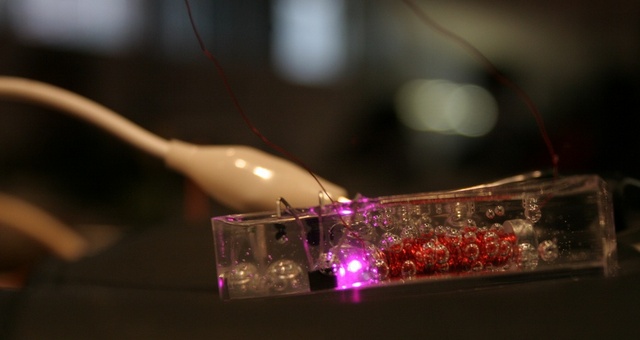
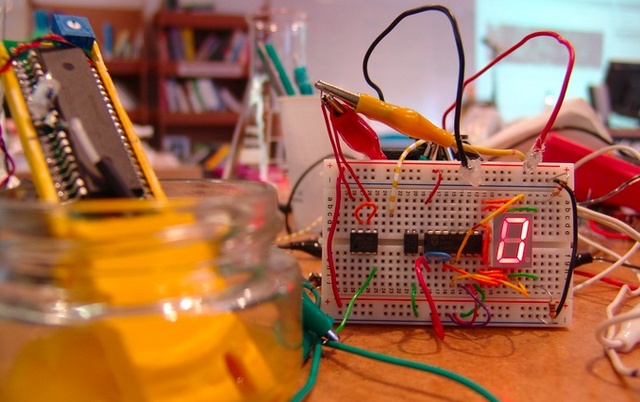
I’ve been covering a few editions of the Interactivos? workshops so far and have usually focused on a couple of my favourite projects. Today however, i thought i’d ask two of the workshop leaders/teachers to give us a broader overview of the workshops, how they evolve, why certain directions are being taken, what the mood is like over these two intense weeks of work, etc.
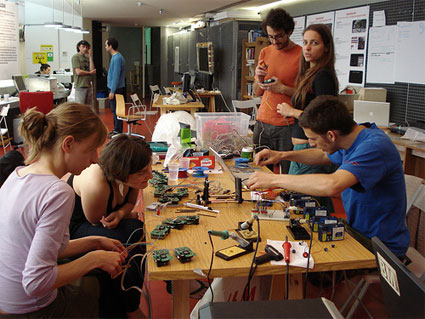
Image Medialab Prado
The teachers tend to change according to the theme of the workshop. This time i met Simone Jones and Alvaro Cassinelli.
Simone Jones is currently an Assistant Dean and Associate Professor of Art at the Ontario College of Art and Design, Toronto where she teaches in the Integrated Media Department. Her work includes kinetic sculpture, film, video and performance.
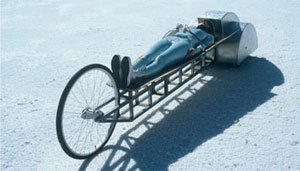 One of her recent works, Perfect Vehicle is a three wheeled vehicle that is approximately 11 feet long. The machine has sensors that monitor her breathing. Breathing (the rate of the rise and fall of her chest) controls the speed of the vehicle. This machine and the driving performance were filmed on the Bonneville Salt Flats (near Salt Lake City, Utah) in 2006. ‘The idea is to create a “science fiction” type of environment where the body is displayed tethered to a vehicle against the surreal backdrop of the Salt Flats;’ explained Simone. ‘This is the third machine that I have built that is made specifically for my body and is worn in a performance that is filmed.’
One of her recent works, Perfect Vehicle is a three wheeled vehicle that is approximately 11 feet long. The machine has sensors that monitor her breathing. Breathing (the rate of the rise and fall of her chest) controls the speed of the vehicle. This machine and the driving performance were filmed on the Bonneville Salt Flats (near Salt Lake City, Utah) in 2006. ‘The idea is to create a “science fiction” type of environment where the body is displayed tethered to a vehicle against the surreal backdrop of the Salt Flats;’ explained Simone. ‘This is the third machine that I have built that is made specifically for my body and is worn in a performance that is filmed.’
Alvaro Cassinelli is Assistant Professor at the University of Tokyo, where he is involved in the development of the Meta-Perception Group. Alvaro gained fame with the Khronos Projector and when i saw him at the Medialab Prado in Madrid, he was not only co-heading the workshop but also developing a new project for Sonarmatica in Barcelona. The theme of the exhibition this year, Future Past Cinema, attempted to create links between the past and the future of Cinema under a single vision. boxedEgo embodied perfectly that concept by the way the installation combine several pre-cinematographic techniques in order to create a new magical, “out-of-body” experience (stereoscope, diorama, peep-show box and pepper ghost effect).
Video:
Here we go now:
The Interactivos?’08: Vision Play workshop took place from May 30 to June
14. That is just 2 weeks and i found the projects quite ambitious. Such a
short period of work has its advantages and downsides. But how do you cope
with the stress of having everything ready and working in just 15 days? What
are the trick to get the work done in such a limited period of time?
Simone Jones:
I believe that one of the reasons that the projects get developed successfully in such a short amount of time is because Interactivos attracts such a talented and diverse group of collaborators. Everyone is aware of the two week deadline and this seems to push people to donate their time in a concentrated way – the stakes are high and the time is short so people cluster together in intense working groups to get the job done. We also relax together at the end of each work day – this gives us the time to get to know one another and build strong relationships (share ideas; brainstorm solutions to problems). Another aspect that contributes to the success of the workshop is the lack of ego among the participants. Because the teachers are flexible with what they “deliver” to the students (the teachers really “respond” to the needs of the group) there is no real agenda. This helps people feel that there is no “hierarchy” of knowledge. All of us are respected as individuals whose strengths emerge from participating in a diverse group. Of course, it is no secret that the work gets done because people work really, really hard too!
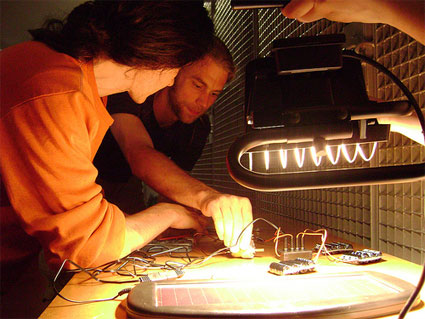
Image Medialab Prado
Alvaro Cassinelli:
I think the “trick” may be three-fold: first, the selection process was quite serious: a lot of effort was put into selecting projects that were enough original and at the same time somehow overlapping, so the skills and resources could be shared. That worked pretty well.
Then, I’d like to stress the fundamental role of the contributors. This is a great formula. Everybody is motivated from the start (artists want of course their projects to succeed, and contributors come to the Medialab willing to learn, but also with a very generous, selfless attitude. With a little bit of luck the teams work quite autonomously. Now, of course, now and then there were some problems: one has to consider for instance that many contributors are also artists in real life, and that the leading role of the “artist” during the workshop may be a little artificial; Plus, individual approaches and interests may conflict: some contributors may push the technical side (because they want to try and improve their skills), while others may rather enjoy doing the concept/artistic critique.
Interesting as those approaches may be, the problem is that there is a very limited time for developing the project, so it is important that somehow the roles stabilize at a certain point, and people choose very concrete responsibilities. To ensure that this would happens, this is perhaps the role that was given to Simone and me, but I have to say that we were quite lucky because most teams worked very efficiently from the start. That being said, Simone and me put a lot of accent on the “critique sessions” (at least one serious meeting with the artists and collaborators for each project), which not only helped clarify the ideas but sometimes threw a completely new light on the project.
The third reason I can think of that may explain the “trick” is of course the Medialab people! there were there for us all the time, always available and with a very positive attitude.
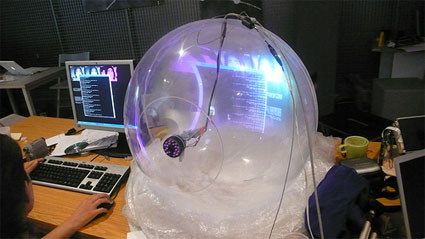
Expanded Eye, work in progress
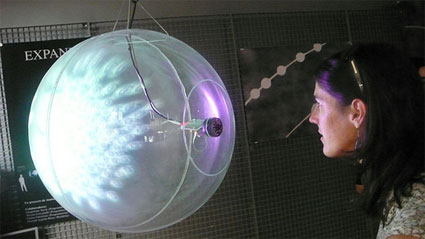
Expanded Eye, by AnaÃsa Franco
How do you work as a teaching team? Do you divide projects between Simone, Alvaro, Julian and the rest of the Medialab team? Or are your skill so complementary that everyone has to be everywhere?
Simone:
I found that we had similar yet diverse skill sets so that we could separate from one another and work on projects that needed our individual skills. This worked really well and allowed participants the freedom to move between the teachers when they needed something specific (technically speaking). We all contributed to the conceptual development of the projects (this is a great time for the teachers to work together in the critiques without having to focus on the technical problems of the work). I assisted participants with electronic and mechanical problems; Alvaro was great with his knowledge of physics, vision and programming; Julian helped a lot with augmented reality and 3D software. We didn’t formally work this out beforehand – we simply responded to the individual projects as they were being developed.
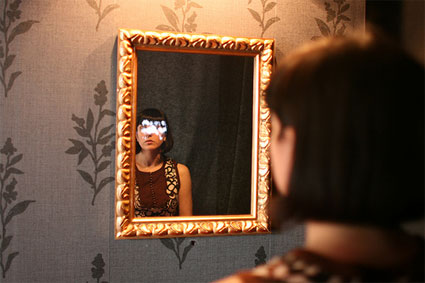
M.A.S.K. (My Alter Self Konciousness), by Jordi Puig
Alvaro:
No, we didn’t divide the projects between the teachers, although of course we naturally got more involved in some projects and less in others. But we tried to constantly monitor the advancement of each project. That was not coordinated at all. Instead, we would discuss from time to time about the problems that were arising and think about how to solve them (directly, or by trying to recruit for a moment a contributor from another project). As for me, that meant that my contribution was “interrupt-driven”, which was extremely tiring but exciting at the same time.
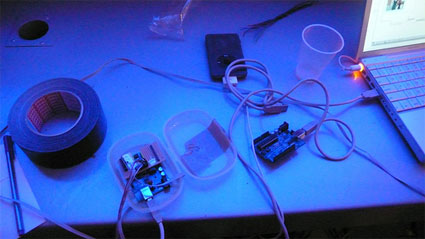
Why this focus on “Vision play” when, as Alvaro puts it “The “magic of the cinema” no longer amazes us because we have become totally accustomed to it.” What are the paths which should still be explored? Beyond higher resolution? Flatter screen? or more realistic 3D experience?
Simone:
This is an interesting question. I think “Vision Play” refers to perception, which is a huge topic that an artist can explore from a variety of positions and with a variety of media. A friend of mine says that “there are always more ways to see” – I love this idea because it points to the complexity of perception and I think this is even more relevant today because of the ways that technology challenges and mediates our experience of the world. Presence (live and virtual) is completely related to perception. We navigate between live and virtual experiences without thinking about it; “vision play” challenges artists to create artworks that engage with this “shifting ground” that characterizes our perceptual connection to the world.
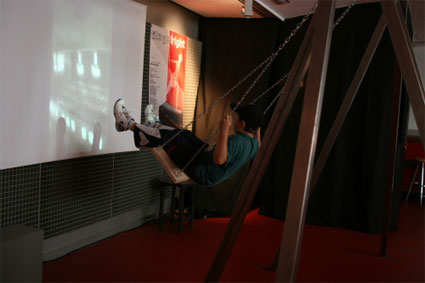
Stage Fright, by Nova Jiang
Alvaro:
Ah! that question again 😉 In fact, I loved the theme from the start, precisely because it was an opportunity to depart from the mainstream computer graphics technology and aesthetics. An opportunity to play with light, mirrors, motion and reflections in search of “illusions” – as we all did when little, when one’s fascination could easily be caught by the patterns of light at the bottom of a cup of tea (a “catacaustic”: a fascinating name too!). There were some projects like that, and although I secretly wished there were more of this kind (and less projects involving computers and displays – as my own by the way!), what we got was really interesting and original in its own way.
In any case, “vision play” was clearly not imagined as a workshop to develop “flatter screens” or “more realistic 3D experiences”; among the project proposals (totaling 98!), there were some that pointed in that direction and I think we consensually rejected them easily on the basis that this workshop was for exploring unknown territories, not an R&D laboratory…
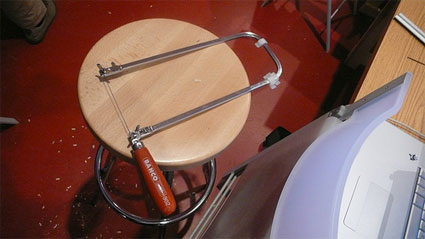
I find the dynamics, open-ness and spirit of the Interactivos? workshops very unique. What is your opinion about it?
Simone:
I agree completely. The environment at Interactivos is like no other experience that I have had. All “residency programs” are intense but Interactivos is different because you participate as a contributer to the group and the overall spirit of the projects rather than as simply an individual artist. Also, the people at the MediaLab are AMAZING! They really set the stage for the spirit of the workshops (and Madrid is a magical city!).
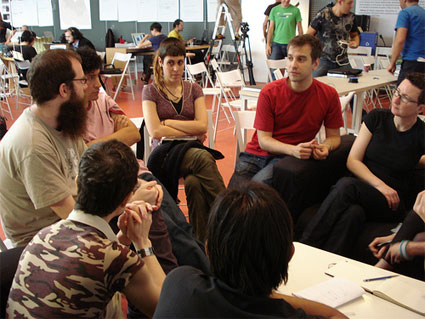
Image Medialab Prado
Alvaro:
Well, for me it was very unique of course!!. A fantastic experience. And I was very lucky to share this teaching experience with Simone, with which we had a very good communication (I hope she shares this opinion with me too! 😉 I just think the workshop should be a little longer – but this may be a feeling we all shared at the end, and that
we all would have shared even if the workshop was made a little longer. Most of us just wanted more of the same. Anyway, I think this is how it works, this is the very essence of the workshop: a fleeting moment that reunites capable and imaginative people for a few days in order to try some magic formulas – the actual magic will crystallize in the future. (Another remark: I think the Medialab need to have the mechanical workshop – now in Matadero – in the the same building as the electronic/computer workshop, this may increase the efficiency of the work being done. It seems that this will happen very soon, when the new space will open.)
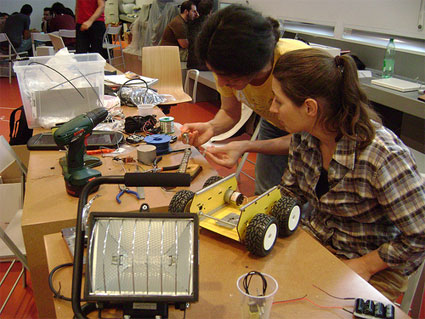
Esther Polak and Pablo Ripollés
The participants of the workshop are asked to use open hardware and open code tools. Apart from the lower cost factor, what makes these open tools really worth working with? Are they already as sophisticated, efficient and reliable as other tools?
Simone:
I find that Open Source software and hardware allows for a completely different approach to learning (specifically learning within a technological framework). For example, when I first began learning electronics (in 1989), the information that I was taught was cumulative and came from a localized environment (within a school). This environment was specific to Toronto and grew slightly once I had graduated and met more people within my local artist community. As I got older and became more experienced and had more exhibitions, my community grew but this was completely contingent on my ability to “physically network”. Today people can access vast amounts of information via the internet. Online communities have extended and sometimes surpassed local communities in ways that I could never have imagined in 1989. I buy and download information from the web instead of going to “specialized” bookstores. Open Source communities post code online. “How to” books proliferate. I have observed people adapting code and hardware solutions to their own projects. Learning is more of a “cut and paste” experience than a cumulative one. This is extremely interesting and challenging for educators who design curriculum with specific “learning outcomes” that are derived from a cumulative process of knowledge acquisition. Knowledge is shared at Interactivos in the same way that knowledge is shared and acquired from the internet and open source communities – an individual has a specific problem that needs to be solved – the approach to solving the problem is directed outwards to a “community” that responds to the question at hand. I think this is a wonderful way to learn – a person is able to build a “toolkit” of knowledge. However, I also think it is still important for people to be able to contextualize what they have learned. This often occurs slowly and cumulatively. Time is a key factor in the overall learning process.
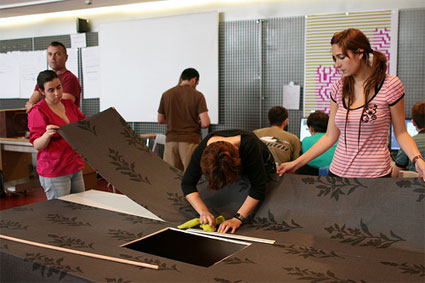
Image Medialab Prado
Alvaro:
This is a very general question, I mean this attitude towards open source tools is not particular to the Medialab-Prado workshop. I do use such tools even at my work at the University. There is some controversy here of course, but as for me, I like to use such open tools in particular because I can be sure there is a community using them, a community that is precisely open to any newcomer (just click here, download, and find some fanatic in your immediate surroundings wishing to “convert” you and explain the mysteries of the hardware/software to you – and all that for free!). As for how efficient and reliable these tools are: this depends, but in the field we are now discussing – I mean, interactive media arts, right? – I think these tools definitely have their place. In the worst case, at least for prototyping. I am thinking in particular about Processing, but if you think about openFrameworks, it potentially enables the fastest processing a particular computer can give you (but the initiative is yet not nearly as developed as Processing is).
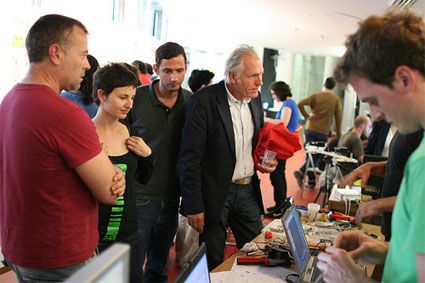
Theo Jansen visiting Medialab Prado
Thanks Simone and Alvaro!
Back to the latest Interactivos? at Medialab Prado in Madrid. Subtitled Vision Play, this edition offered artists and other creative people the opportunity to create prototypes for exploring image technologies and mechanisms of perception, using open hardware and open code tools.
When it comes to exploring image technologies in a striking and poetical way, i’d say that Karolina Sobeka is certainly one of the most talented artists i’ve ever met. A couple of years ago, she developed the mesmerizing wildlife backseat projection which she showed in several countries. This time she was in Madrid to bring into being the Immodesty project.
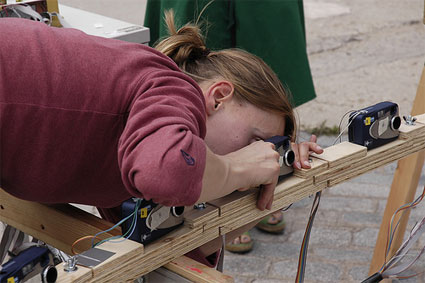
Image courtesy of Emanuel from tagr.tv
This system is a prototype for a portable image recording system based on cheap, disposable multiple cameras positioned along a path. Controlled by a microcontroller, each camera can be assigned an individual time delay.
The aim of the project was to create an affordable platform which enable all kinds of temporal-spatial experimentation. Their first prototype for example, tried to re-conceive or visualize a spatial perception which expands the body’s point of view in space. Check out the videos on the project website to get a clearer idea of what the project is about.
What was the inspiration the Immodesty project? How did you come up with that idea?
My background is in animation and video, and I’ve always been interested in making videos whose structure is manipulated at a very basic level, frame by frame, and that say something about our perception of time or space or point of view. These three elements are normally linked as the camera simulates our experience of visual perception. If we disassociate them, we can step outside this experience and maybe ‘cheat’ the laws of physics. There is something magical about seeing physical reality from a point of view that this reality precludes.
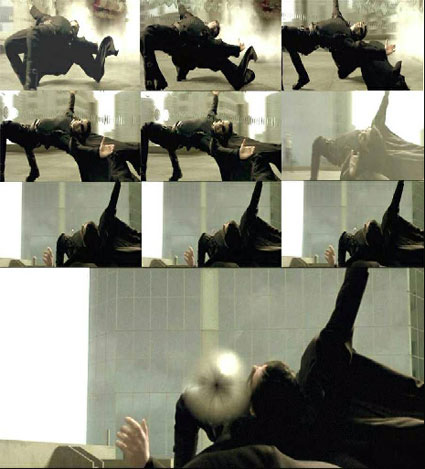
Screenshots from The Matrix (image the raw feed)
The kinds of videos I wanted to make would call for the multi-lens camera set-ups (which do exist — and which were made famous by the bullet time effect from Matrix — but are very out of financial reach for an independent artist). So when I had an idea for a video that would require a fast and long vertical movement of the camera, Interactivos? call came along for ‘Vision Play’ projects. During the workshop I wanted to create a reconfigurable recording system, which could be used to create many different kinds of content, a tool for artists to experiment with, as well as to demonstrate one kind of recording paired with one kind of display. Since I’ve been interested in the viewer’s interaction with an image and in the bodily experience of space, I ended up going with recording moments in time from multiple points of view, and building narrative with them. The narrative would unfold as the viewer explored these moments by moving through space. The change in perspective gives the viewer new information about the scene she’s watching. It is a similar experience as when you walk by an open door and only see a fragment of the scene at a time. Your movement reveals the space and the story. When you come back to the doorway the scene is different, the story has advanced. In the installation the viewer would be able to approach the story from either direction, and once she’s seen the entire ‘moment’, a new one will be loaded that shows another moment in the same story.
I think this is a nice metaphor for the scope of our attention, always moving from detail to detail to sequence them together in a sense-making pattern.
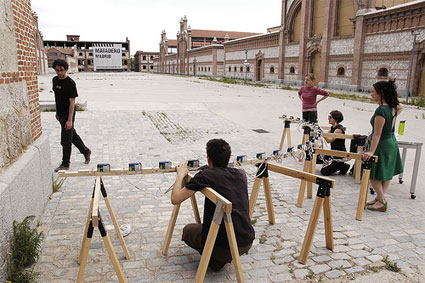 height=”283″ class=”mt-image-none” style=”” />
height=”283″ class=”mt-image-none” style=”” />
Image courtesy of Emanuel from tagr.tv
Immodesty seems to be very complex from the technology point of view. Which kind of challenge did you encounter while developing it and how did you overcome them? Did the difficulties make you modify any aspect of the project?
In a way the technology to make it possible existed already when Eadweard Muybridge was arranging his cameras sequentially along the path and triggering the shutters — the complex part is turning it into a portable, modular system that’s affordable and easy to experiment with. For a while the biggest challenge to creating a system like this was the expense of technology, but today the prices of cameras are dropping, it’s conceivable to use lots of them for one project, and it is possible to imagine it as a tool for experimentation. The cameras are also getting smaller and lighter, which make it possible to make a portable rig and to manipulate and position the cameras more freely.
This project posed many challenges, for example designing and building a modular reconfigurable rig, that would at the same time provide the rigidity and near-perfect alignment for the cameras. We ended up creating a wooden module for each camera that could be angled independently in the horizontal plane and that still allowed the cameras to be tilted and adjusted by hand. Most challenges were overcome after a lot of head-scratching thanks to the great help of the awesome collaborators and instructors at the workshop. One problem however that we couldn’t go around was the inconsistency in the time delay between the triggering of the shutter and the camera capturing an image, which made impossible the precision necessary for achieving some nice time effects. For the next version of the project I’m planning to use different cameras, hopefully solving this problem. This time we used the Dakota disposable digital cameras, the least expensive option, and which I liked because of utilizing the hack developed for these cameras when they came out, though it might have proved to be more of a trouble than benefit.
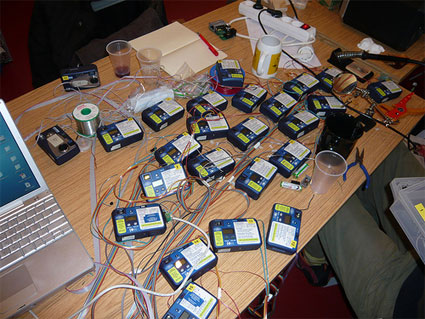
Image courtesy of Emanuel from tagr.tv
Creating the interactive display also posed some challenges. We had barely any time to put the installation together and could barely give enough consideration to the spatial arrangement, and to making sure that the size of the image and change in the projection felt correct in relationship to the viewer’s movement.
The project plays with spatio- temporal situations. Can you describe the kind of experimentation the multi camera system can give life to? Did any application emerge over the course of the development that you had not thought about before?
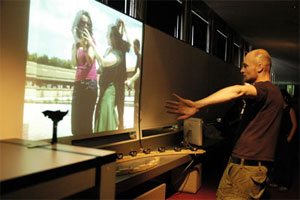 I think it would be interesting to record things impossible to experience physically: extremely slowed-down time flow while the movement in space is fast, or camera movement in the ‘frozen instant’ combined with a display in a ‘augmented reality’ system. For example I would like to create a spherical rig to record spherical video (the cameras would all be triggered at the same time and the images stitched into a large spherical map) that could be explored in a custom interactive display. It could be used for exploring movement and perception not possible through our physical bodies: for example my initial idea to create the vertical camera movement, in a video shot from a point of view of someone who is jumping higher and higher, way beyond human capabilities. I can also imagine it being used as a ‘wearable’ recording system, lightweight enough that it could be carried around while recording.
I think it would be interesting to record things impossible to experience physically: extremely slowed-down time flow while the movement in space is fast, or camera movement in the ‘frozen instant’ combined with a display in a ‘augmented reality’ system. For example I would like to create a spherical rig to record spherical video (the cameras would all be triggered at the same time and the images stitched into a large spherical map) that could be explored in a custom interactive display. It could be used for exploring movement and perception not possible through our physical bodies: for example my initial idea to create the vertical camera movement, in a video shot from a point of view of someone who is jumping higher and higher, way beyond human capabilities. I can also imagine it being used as a ‘wearable’ recording system, lightweight enough that it could be carried around while recording.
Many people brought many different ideas to this project — from an architectural point of view it could be used to create ‘virtual spaces’ or ‘expanded screen’. Someone working with stereo imagery, like Alvaro, would be interested in creating stereo videos using parallel camera paths. It could serve as a kind of a ‘total view’ mirror.
Several ideas came up also for using it interactively and hopefully we’ll be making some of them real soon!
Do you plan to develop the project any further?
Yes, definitely. What we developed at Interactivos? was a very imperfect prototype, which demonstrated only one simple application. There is definitely plenty of room for improvement and for taking it into many different directions. I’m planning to use different cameras that will allow more flexibility: automatic download or even real time image capture, perhaps video recording capability, etc. Hopefully we’ll be able to bring to life some of the ideas that came up during Interactivos? and I’ll be able to create more videos and installations.
I’m definitely open to any ideas people might have for using it, and once we have our second prototype that’s a little more stable it would be great to make it available for different kinds of projects.
Thanks Karolina!
Waaaah! Two whole days without airports nor art exhibitions. Which means that i’ll finally have some time to write about several shows and events i visited over the past few weeks.
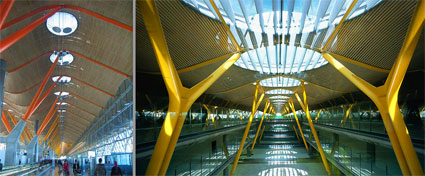
Barajas airport by Richard Rogers
Talking about airports i have the feeling that i’ve spent so much time this year at the gorgeous Terminal 4 of Barajas airport that i should probably update my dopplr account and write that my home city these days is MAD T4. My last visit there was when i went to check out the results of the Interactivos? workshop at Medialab Prado.
The projects selected saw their lucky authors guided through the whole development process by Ãlvaro Cassinelli, Simone Jones, and the Medialab Prado research group integrated by Julian Oliver, Pablo Valbuena and Daniel Canogar.
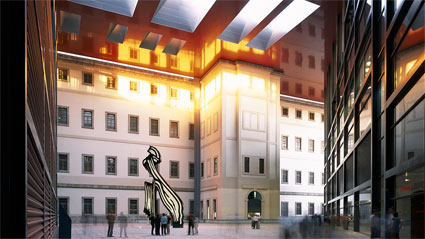
Reina Sofia Museum Extension. Photo: Philippe Ruault
Going to Medialab Prado is always a great pleasure, there are tortillas de patatas all over the city, Medialab’s headquarters are located in the heart of Madrid’s cultural district, a few meters away from the Jean Nouvel-revamped Reina SofÃa Museum, and now, right in front of Medialab Prado there’s one of the most stunning Herzog & de Meuron‘s work ever: an ex-power station turned into the social and cultural center of Caixa Forum’s Obra Social. The architects played one of their usual abracadabra tricks and removed the base of the building to leave a covered plaza under the brick structure, which now appears to float above visitors’ heads. The roof is no less admirable wrapped as it is in rusty steel panels. Alongside the building is one of those vertical gardens that made the fame of French botanist Patrick Blanc.
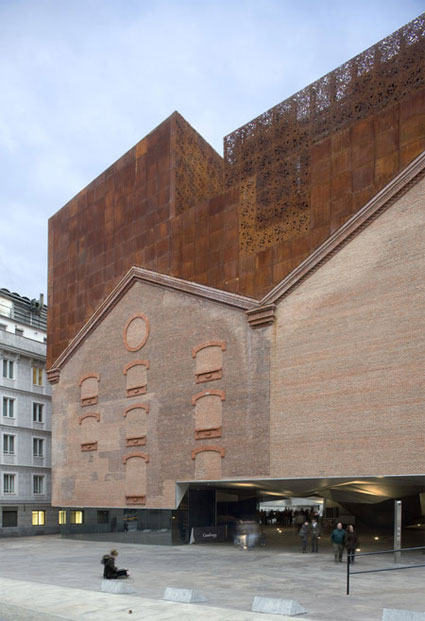
Caixa Forum, Madrid. Image Duccio Malagamba
The presentation of the projects realized during the workshop at Medialab Prado took place on June 14. There weren’t quite as many visitors as there were spectators cheering in front of their screen to see the football match opposing Spain to Sweden that evening. Still, the place was packed, the show was exciting, there were free beers and artists delivering a moving Oscar ceremony-style performance, saying how wonderful the workshop had been and thanking everyone that had made their project possible.
I’ll be detailing some of the projects over the next few weeks. Today i asked Barcelona-based Eloi Maduell Garcia to talk us through his Augment(0)scope work. Inspired by visualization and optical devices from XVIII century, this instrument allows spectators to take a peek trough its lens and discover an interactive projection, a circular panorama made of hundreds of pictures culled from the Greenpeace-Spain photoblog fotodenuncia. On this website, users from all over Spain are posting and tagging environmental misdeeds that are in urgent need of receiving more attention from politicians in the country.
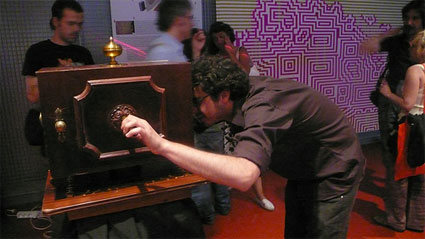
Your original proposal involved a “box will be hanging on the ceiling over user’s head”. the final installation is different. What made you change your mind about the setting? Are there other elements of the projects which had to be modified due to some technical or other aspects that emerged during the working process?
Well the initial idea was something more similar to a “periscope”, i liked the idea of building something coming from the Twenty Thousand Leagues Under The Seas from Jules Verne, something that in my imaginarium is related with old times and technology which was my intention. The problem that changed my initial design was so simple : with the materials that we had available in MediaLab workshop it was too difficult to build up a mechanical object which could give power and signal to the hardware (VGA + USB serial port wires) and which could be able to rotate freely 360º. It’s a really basic and mechanical problem, that tells us about the limitations we have with “electrical” and so “digital” art, we can’t get rid of being wired to power!
We solved the problem by making the structure stand in a rotatory base with the computer and all the hardware on it, so then the problem was restricted to give power to the whole rotary hardware system, so just 2 wires (+ – ) . We looked in the industry for rotary connectors but what we found was so expensive that we decided to do one DIY ourselfes : on the floor base we fixed 2 cooper discs separated by a small step and on the rotary structure we put 2 cooper heads which were contacting the bottom cooper discs, so then the upper structure was turning over a central axe with weels and gived us power to the whole hardware.
That was the basic change over the initial hardware design, it was important for me to try to keep the 360º capacity of rotation, to give a sense of freedom of immersive rotation. By giving a real rotation range, people could feel and understand that turning in the real world meant a turn in the virtual world, reinforcing the idea of freedom inside the visualization orientation.
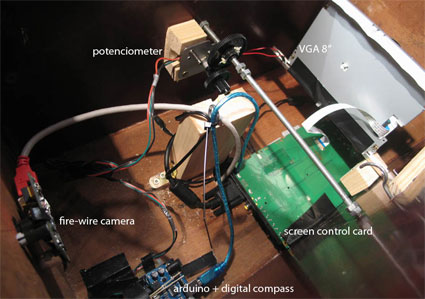
Image courtesy of the artist
In the software side also during the process with collaborators some simplifications were done because there were not that many coders in the group, so we decided to make it more simple, and basically meant to forget about using Augmented Reality techniques in the set. At the same time those techniques after the collaboration process were partially not needed at all so we decided to don’t use them.
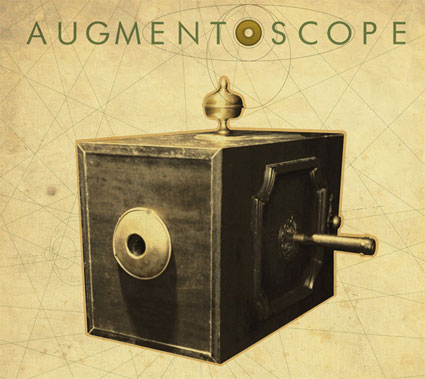
Why did you choose to keep a “vintage” and early cinema look to the project? How important is the retro design for augment(o)scope?
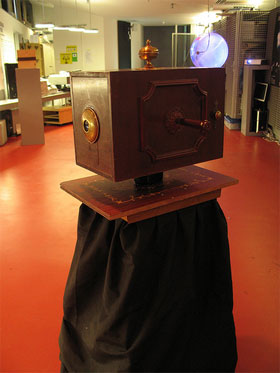 Well in fact it was part of the initial idea, to return to the very basics of immersive engineering, where just lenses and perspective drawing could give people from XVIII century the feeling of being in another reality. The intention was to make something similar with present technology, but the outside look of it should remind us the “old times” to show that in fact, just the vision technology around this installation had changed, the “fair” attraction that the piece produces is closely the same as back in time.
Well in fact it was part of the initial idea, to return to the very basics of immersive engineering, where just lenses and perspective drawing could give people from XVIII century the feeling of being in another reality. The intention was to make something similar with present technology, but the outside look of it should remind us the “old times” to show that in fact, just the vision technology around this installation had changed, the “fair” attraction that the piece produces is closely the same as back in time.
That’s an important part of the piece, to keep a vintage look on the outside, but a present technological hardware on the inside.
Augment(o)scope tells us about time passing by, it’s an optical instrument coming from the past that told to us about present and so future times. That’s why half of the project is the box look, the other half is the content visualized inside. The installation suggests that nothing has changed at all since then. Environmental conscience hasn’t been developed that much as technology for example.
Can you discuss the content of what users can see inside the device? Why did you choose to display this kind of data (once again it seems different from what i could read in the original proposal written down in the forum page)?
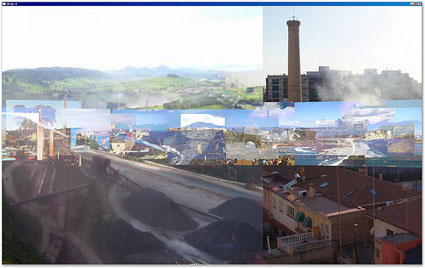
Image courtesy of the artist
First of all i’ve to say that my initial proposal wasn’t really closed when i got to the first presentation on MediaLab and i was looking for a collaborative process from the early stages of the project so the group would be able to discuss the content and the way things will happen inside the installation. That’s why the original proposal changed or evolved from an initial display to a different one, that was an important part of my needs on that workshop.
We made quite a lot of discussion sessions with all the group about which data to use and how to interact and finally we decided to communicate with Greenpeace Spain which has a website called fotodenuncias which is a photoblog where any user could post picture on a map in Spain to denounce environmental misdeeds. They accepted to collaborate so we got the whole pictures and locative data database from the mapXperience.com studio.
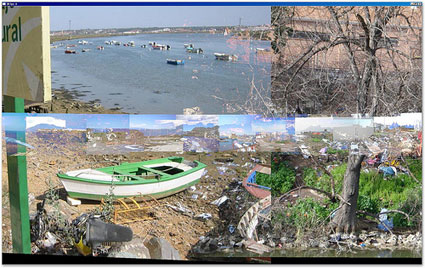
Image courtesy of the artist
All these pictures and datas are made by individual people who are creating an interactive collaborative piece without knowing it at all. I liked the idea of putting the effort of many people together to empower or amplify their consequent actions.
At the end what we have inside is a collection of circular nested panoramas of the pictures from the website. From the user’s point of exploration it gives a strange vision of a virtual landscape full of pollution, destruction and contamination. The user could move forwards and backwards with a lever and turn around to explore this several layers of blended panorama’s.
Are the images geo-located?
On the present version they’re not geolocated. The images inside have been chosen to “match” as if they were part of a continuous panorama. For example image i has some relation with image i+1 and i-1. When i say “relation” i mean, for example, that if in “image i” we’ve a coast line and the sea line in the horizon, then image i+1 has a sea line also and a the line of the horizon is closer to the last one. At this stage, it was more important to give an idea of a continuous landscape than its geolocation. In next versions i’d like to implement some kind of geo-located distribution (as that was the original idea and concept of orientation). We already have the data associated with each picture so it’s totally doable.
Another thing that is left for the next version is the text data associated with each image. Every image has a text related to it, so this text would be used a part of the texture and information augmentation in next releases.
So you plan to further develop the project?
Well, I have a good relation with the company which created the site and they are open to update the data from the new posts. That could be a way to keep updating the pictures.
Also there are some functionalities that i would like to add to the project as we had no time at all to develop them during the workshop and evolve the first prototype to a more clean and accurate version.
So yes i’m planning to keep working on it and explore other ideas related to the project. An object that let us cross the walls and see what’s on that direction, orientation, space and from the past to the future 😉
Thanks Eloi!
I might get what? 2 or 3 emails per day from people who ask me to write a story to promote their own event. I would love to help everyone but publishing every single call and event i hear about would be a full time job and i am not up for that one.
Besides, my readers know very well that they can find this sort of information on rhizome (who btw has a commission call for media art works running), networked_performance and various mailing lists. Wmmna is mostly about reports from exhibitions i’ve seen around which leaves no space to announcements. However, there are exceptions to this rule, wmmna is a personal blog and as such highly subjective, so once in a while (read every 6 months) i will blatantly favor organizations i like A LOT because i know each of them treat artists as well as they deserve. So here, dear readers, two calls for proposals which might give you the opportunity to get some fantastic holidays in Spain develop your own project in the best conditions you could dream of:
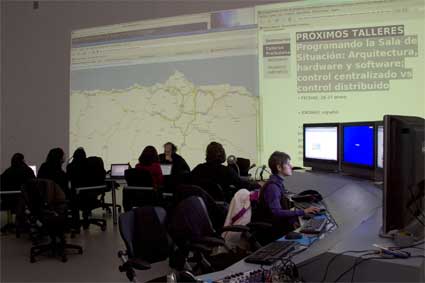
Situation Room. Image Julio Calvo. Courtesy of LABoral
– LABoral is launching two calls. One is for a curator in residence. Curators and researchers interested in media and visual arts, gaming, robotics, architecture, design, ecology, science, technology, interdisciplinary and emerging forms of art are invited to develop a research and production project at LABoral, Gijon, for two months during 2008. Deadline is May 30 and if i wasn’t already so busy answering all those emails from people who ask me to promote their events i would be very tempted to submit my candidacy.
LABoral is also calling for proposals from artists to develop a research and production project at LABoral for two months during 2008. Same deadline: May 30, 2008.
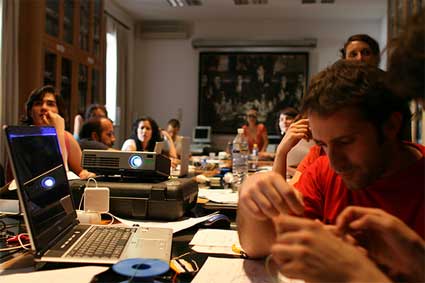
Image Medialab Prado
– Meanwhile Medialab-Prado is also looking for the submission of projects to be carried out as part of the production-oriented Interactivos?’08: Vision Play workshop, which will take place from 30 May to 14 June 2008 in Madrid. The workshop aims to use open hardware and open code tools to create prototypes for exploring image technologies and mechanisms of perception.
The Interactivos? workshop will be lead by Ãlvaro Cassinelli and Simone Jones, with the participation of the research group Light, space and perception (Daniel Canogar, Julian Oliver and Pablo Valbuena.)
Deadline: 25th April.
Related: my previous posts about the Interactivos? workshops and about LABoral (i also wrote an article about them in Art Review a while ago.)
While i’m at it, i’ll also mention (but i don’t know them as well as Medialab Prado and LABoral) that NEW LIFE BERLIN is taking place in Berlin from June 1-15th, 2008 and artists are encouraged to apply for participation now.
The festival is organized by the wooloo and is open to international artists.